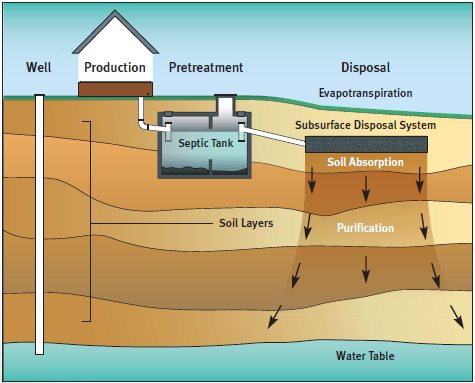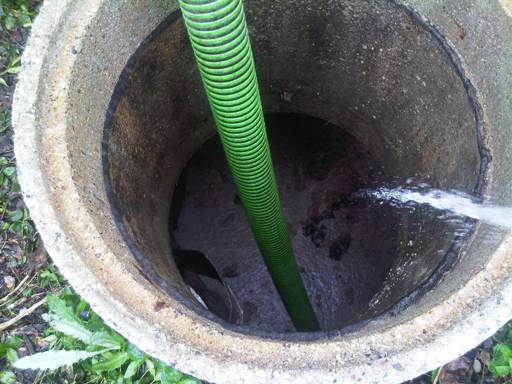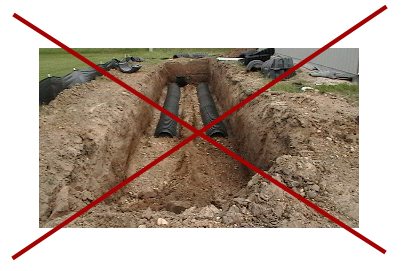How Does a Septic System Work?
Septic system perform the same essential function: process wastewater and return it to the water table. You will discover that maximizing the time that bacteria can breakdown organic material is critical. You will learn that hydraulic loading greatly affects the ability of the septic system to perform. Discover that Aero-Stream can extend the life of your septic system indefinitely by executing a controlled aerobic septic system conversion for under $1700!
Septic System Introduction
There are passive and active systems. The overwhelming majority of residential systems are designed as passive systems. The basic components of a passive septic system are an inlet pipe which carries the household wastewater from the home to the septic tank, the septic tank, and an absorption component, most commonly a gravity drainfield.
Unfortunately septic systems are designed to fail. The average system has a useful life of 15-20 years. when the system fails the typical remedy is to replace the drainfield or sometime the entire system will need to be replaced. This is a very expensive endeavor ranging from $7,000 as high as $100,000 depending on the site conditions.
Fortunately you have discovered Aero-Stream. We have a guaranteed solution to restore your septic system for a fraction of the cost to replace it!

Septic System Operation
Inside the septic tank is a large population of living microorganisms called anaerobic bacteria. The quantity of anaerobic bacteria is dependent on the solid organic material in the wastewater for source of food. Therefore, when the loading into the septic tank is low, the anaerobic bacteria count declines and when water usage peaks, the anaerobic bacteria count increases. An example would be when a family takes a vacation and the house is vacated. Water usage is nonexistent, so the anaerobic bacteria count decreases.
The design of a septic tank will always maintain a minimum water level to allow the anaerobic bacteria to remain in existence at all times. At times of peak water usage such as a clothes washer or dishwasher emptying or when additional people are occupying the home, such as a family gathering, the loading of wastewater into the septic tank is high and the anaerobic bacteria count increases.
Because the slow acting anaerobic bacteria, maximizing the length of time the wastewater is in contact with the anaerobic bacteria in the septic tank is critical. This is referred to as “holding time” and is described as the amount of time it takes the wastewater to flow across the tank from the inlet to the outlet of the tank.

In general, the septic tank is designed to hold the wastewater for approximately 2 days. During this holding period, the anaerobic bacteria breakdown the organic material in the wastewater, reducing its strength by 40%, on average. As water usage varies, the volume of flow through the septic tank increases or decreases proportionately, which in turn increases or decreases the holding time and the amount of processing in the tank.
Once the wastewater reaches the tank outlet, the semi-processed effluent (still containing on the average 60% of its original organic material) flows out to the drainfield carrying anaerobic bacteria with it. In the drainfield, the anaerobic bacteria partially completes the treatment of the effluent, removing more of the remaining organic material prior to being absorbed into the groundwater.
The problem with this design, as will be described in detail in later sections of the manual, is that the anaerobic bacteria do not break down enough of the organic material in the tank or in the drainfield, resulting in dire consequences for the service life of the system.
In the past, a property owner had limited options to resolve a failed or failing septic system suffering from a clogged drainfield.
The most common action for a failed septic system involved replacing the clogged drainfield and septic tank.
Septic system replacement typically costs $7,000 to $100,000 or more, dependent on the system type being replaced and if or if not the cost is financed.
The New Solution For a Failed Septic System
Aero-Stream® has developed and patented a retrofit aerobic system for onsite septic systems. The Aero-Streams® Remediation System restores and extends the life of a failed or failing septic systems by generating an environment that encourages the growth of aerobic bacteria. You will save thousands of dollars and avoid all of the problems and the hassles and that are associated septic system replacement. The Aero-Stream® equipment can be installed in your septic tank without excavating your yard.
For more than 100 years the aerobic treatment of septic sewage has been used. As one of their primary treatment processes, aerobic treatment is utilized in nearly every municipal wastewater treatment plant. The aerobic process is fast, robust, and efficient at decontaminating the wastewater.
Aero-Stream® uses this technology in your existing septic system to restore a failing or failed d septic system. The environmental changing from anaerobic to aerobic in the system, 90% of the organic matter is expended by the aerobic bacteria in the septic tank. This results in reduced organic material leaving the septic tank as food for the bio-mat to live on in the drain field.

Additionally, oxygen rich water and aerobic bacteria streams into the drain field which creates an environment for the aerobic bacteria to digest the bio-mat. When the bio-mat is digested and dying-off, the drain field soil begins to be permeable again and the system performance returns to original condition.
If your septic system is failed or is failing, this decision is easy to make. If your system is only a few years old you can prevent the headache of septic system failure in the future. Backed by a strong guarantee, the Aero-Stream solution has restored successfully thousands of failed and or failing septic systems all over North America. Eliminate septic system problems for good and call us today.
